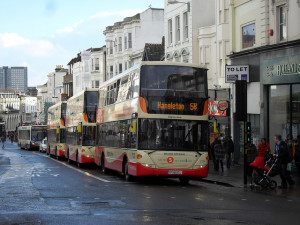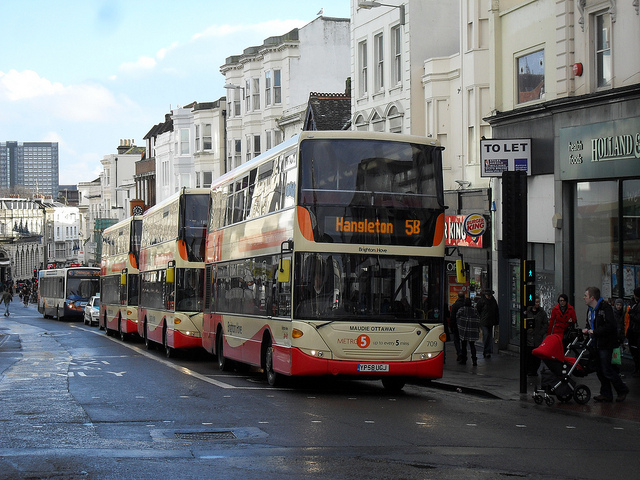Bus use in Brighton and Hove is rallying again after last year’s dip in passenger numbers – the first time trips fell in 20 years.
 Roadworks, staff shortages and unreliable live bus timetables were blamed for a 3% fall in the number of journeys fell in 2014/15, bucking the usual trend of a 3% rise.
Roadworks, staff shortages and unreliable live bus timetables were blamed for a 3% fall in the number of journeys fell in 2014/15, bucking the usual trend of a 3% rise.
But more staff, an updated real time information and the conclusion of all the city’s major roadworks means the bus company is seeing signs more people are using buses once again.
The news was reported at last week’s Buswatch meeting at Brighton Town Hall. Chair Andrew Boag said: “During the period there were a series of roadworks which created major delays to bus services. These included the Vogue gyratory, Brighton Station, Edward Street and North Street.
“The main bus company also suffered from staff shortages which exacerbated the delays because some buses were cancelled while others were being held up. On top of that the real time information system was being updated so electronic displays were often unreliable or missing completely. The overall effect was to undermine confidence in our bus service and people voted with their feet.
“Lessons need to be learnt from this experience. The top priority for the Council must be to give more attention to keeping buses moving during traffic schemes.
“There are some promising signs here as the city council has been in discussion with bus companies on ways of mitigating the impact of future roadworks. The major Valley Gardens project due to begin in the coming months will be the first test of this strategy.
We are told Brighton and Hove Buses has reduced its staff shortage and buses are no longer being cancelled regularly for that reason.
“The real time information system has improved in recent weeks is at last becoming reliable again. Some bus services which suffered from poor reliability have been re-timetabled.
“It is particularly encouraging to see that bus companies are not reacting to the fall in numbers by reducing service levels; instead they are investing in anticipation of future growth.
“So the overall outlook is much brighter and with fewer roadworks planned for this year there are already some signs more people are using buses again, especially on those routes that have been improved.”









It’s good to hear from the bus fan club, but how much did bus travel increase last year?
And how much of the drop in bus travel is a result of the high fares and slow journeys as the ever increasing number of buses queue through the centre of Brighton?
It is now generally cheaper, faster, and more convenient to drive to other towns in the area rather than attempt to bus into Brighton, or even worse to go to somewhere else via the centre of Brighton (aka the extended bus station).
It would be a lot better is Buswatch actually represented bus users rather than seemingly be a tame PR agency.
Bus use fell from 45.8 million journeys to 44.4 million journeys in the year to March 2015 according to figures released by the Department for Transport. Buswatch is simply reporting the facts, we are certainly not a ‘tame PR agency’, as you imply. Our October newsletter includes a 20 point plan for improving bus services and getting more people on buses, which is what we are all about. More people travelling by bus means fewer cars clogging our congested streets so everyone gets through quicker.